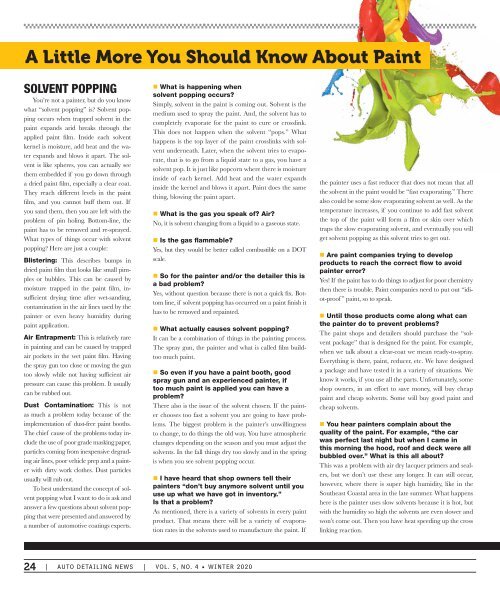Auto Detailing News Winter issue
You also want an ePaper? Increase the reach of your titles
YUMPU automatically turns print PDFs into web optimized ePapers that Google loves.
A Little More You Should Know About Paint<br />
SOLVENT POPPING<br />
You’re not a painter, but do you know<br />
what “solvent popping” is? Solvent popping<br />
occurs when trapped solvent in the<br />
paint expands arid breaks through the<br />
applied paint film. Inside each solvent<br />
kernel is moisture, add heat and the water<br />
expands and blows it apart. The solvent<br />
is like spheres, you can actually see<br />
them embedded if you go down through<br />
a dried paint film, especially a clear coat.<br />
They reach different levels in the paint<br />
film, and you cannot buff them out. If<br />
you sand them, then you are left with the<br />
problem of pin holing. Bottom-line, the<br />
paint has to be removed and re-sprayed.<br />
What types of things occur with solvent<br />
popping? Here are just a couple:<br />
Blistering: This describes bumps in<br />
dried paint film that looks like small pimples<br />
or bubbles. This can be caused by<br />
moisture trapped in the paint film, insufficient<br />
drying time after wet-sanding,<br />
contamination in the air lines used by the<br />
painter or even heavy humidity during<br />
paint application.<br />
Air Entrapment: This is relatively rare<br />
in painting and can be caused by trapped<br />
air pockets in the wet paint film. Having<br />
the spray gun too close or moving the gun<br />
too slowly while not having sufficient air<br />
pressure can cause this problem. It usually<br />
can be rubbed out.<br />
Dust Contamination: This is not<br />
as much a problem today because of the<br />
implementation of dust-free paint booths.<br />
The chief cause of the problems today include<br />
the use of poor grade masking paper,<br />
particles coming from inexpensive degrading<br />
air lines, poor vehicle prep and a painter<br />
with dirty work clothes. Dust particles<br />
usually will rub out.<br />
To best understand the concept of solvent<br />
popping what I want to do is ask and<br />
answer a few questions about solvent popping<br />
that were presented and answered by<br />
a number of automotive coatings experts.<br />
• What is happening when<br />
solvent popping occurs?<br />
Simply, solvent in the paint is coming out. Solvent is the<br />
medium used to spray the paint. And, the solvent has to<br />
completely evaporate for the paint to cure or crosslink.<br />
This does not happen when the solvent “pops.” What<br />
happens is the top layer of the paint crosslinks with solvent<br />
underneath. Later, when the solvent tries to evaporate,<br />
that is to go from a liquid state to a gas, you have a<br />
solvent pop. It is just like popcorn where there is moisture<br />
inside of each kernel. Add heat and the water expands<br />
inside the kernel and blows it apart. Paint does the same<br />
thing, blowing the paint apart.<br />
• What is the gas you speak of? Air?<br />
No, it is solvent changing from a liquid to a gaseous state.<br />
• Is the gas flammable?<br />
Yes, but they would be better called combustible on a DOT<br />
scale.<br />
• So for the painter and/or the detailer this is<br />
a bad problem?<br />
Yes, without question because there is not a quick fix. Bottom<br />
line, if solvent popping has occurred on a paint finish it<br />
has to be removed and repainted.<br />
• What actually causes solvent popping?<br />
It can be a combination of things in the painting process.<br />
The spray gun, the painter and what is called film buildtoo<br />
much paint.<br />
• So even if you have a paint booth, good<br />
spray gun and an experienced painter, if<br />
too much paint is applied you can have a<br />
problem?<br />
There also is the <strong>issue</strong> of the solvent chosen. If the painter<br />
chooses too fast a solvent you are going to have problems.<br />
The biggest problem is the painter’s unwillingness<br />
to change, to do things the old way. You have atmospheric<br />
changes depending on the season and you must adjust the<br />
solvents. In the fall things dry too slowly and in the spring<br />
is when you see solvent popping occur.<br />
• I have heard that shop owners tell their<br />
painters “don’t buy anymore solvent until you<br />
use up what we have got in inventory.”<br />
Is that a problem?<br />
As mentioned, there is a variety of solvents in every paint<br />
product. That means there will be a variety of evaporation<br />
rates in the solvents used to manufacture the paint. If<br />
the painter uses a fast reducer that does not mean that all<br />
the solvent in the paint would be “fast evaporating.” There<br />
also could be some slow evaporating solvent as well. As the<br />
temperature increases, if you continue to add fast solvent<br />
the top of the paint will form a film or skin over which<br />
traps the slow evaporating solvent, and eventually you will<br />
get solvent popping as this solvent tries to get out.<br />
• Are paint companies trying to develop<br />
products to reach the correct flow to avoid<br />
painter error?<br />
Yes! If the paint has to do things to adjust for poor chemistry<br />
then there is trouble. Paint companies need to put out “idiot-proof<br />
” paint, so to speak.<br />
• Until those products come along what can<br />
the painter do to prevent problems?<br />
The paint shops and detailers should purchase the “solvent<br />
package” that is designed for the paint. For example,<br />
when we talk about a clear-coat we mean ready-to-spray.<br />
Everything is there, paint, reducer, etc. We have designed<br />
a package and have tested it in a variety of situations. We<br />
know it works, if you use all the parts. Unfortunately, some<br />
shop owners, in an effort to save money, will buy cheap<br />
paint and cheap solvents. Some will buy good paint and<br />
cheap solvents.<br />
• You hear painters complain about the<br />
quality of the paint. For example, “the car<br />
was perfect last night but when I came in<br />
this morning the hood, roof and deck were all<br />
bubbled over.” What is this all about?<br />
This was a problem with air dry lacquer primers and sealers,<br />
but we don’t use these any longer. It can still occur,<br />
however, where there is super high humidity, like in the<br />
Southeast Coastal area in the late summer. What happens<br />
here is the painter uses slow solvents because it is hot, but<br />
with the humidity so high the solvents are even slower and<br />
won’t come out. Then you have heat speeding up the cross<br />
linking reaction.<br />
24 | AUTO DETAILING NEWS | VOL. 5, NO. 4 • WINTER 2020

















